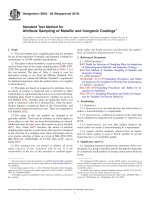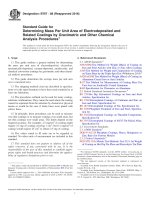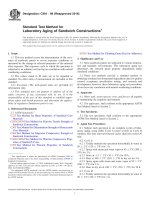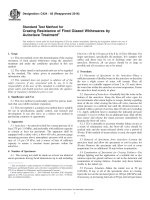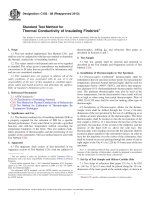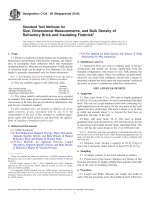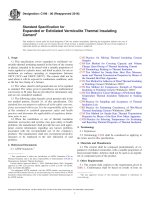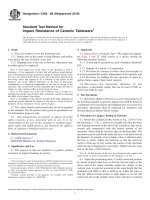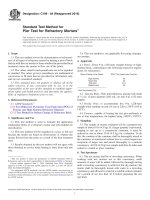Astm c 368 88 (2016)
Bạn đang xem bản rút gọn của tài liệu. Xem và tải ngay bản đầy đủ của tài liệu tại đây (138.27 KB, 4 trang )
Designation: C368 − 88 (Reapproved 2016)
Standard Test Method for
Impact Resistance of Ceramic Tableware1
This standard is issued under the fixed designation C368; the number immediately following the designation indicates the year of
original adoption or, in the case of revision, the year of last revision. A number in parentheses indicates the year of last reapproval. A
superscript epsilon (´) indicates an editorial change since the last revision or reapproval.
1. Scope
4. Apparatus
1.1 This test method covers the following tests:
1.1.1 Impact tests at the center of both flatware and hollow
ware and at the rim of hollow ware, and
1.1.2 Chipping tests at the rim of flatware. Specimens may
be either glazed or unglazed.
4.1 Impact Tester, Pendulum Type—The impact test apparatus (Figs. 1 and 2)2 shall consist of a device having the
following essential features:
4.1.1 A steel tup of specified size and of hardness Rockwell
C55,
4.1.2 Support of a tup by a V-suspension,
4.1.3 Provision for a means of release from fixed heights so
as to give reproducible results, independent of the operator, and
4.1.4 Provision for holding the test specimen in place by
spring clamps against rigid metal supports.
NOTE 1—The impact test at the center of the specimen is used to
determine: (1) the magnitude of a blow that will produce initial fracture,
and (2) the amount of energy necessary to produce complete failure. In the
first case, the initial fracture shows on the side of the piece opposite from
that being struck and appears to be a function of the square of the
thickness and of the inherent brittleness of the body or body-glaze
combination; it is relatively independent of the size or design of the
specimen. The second factor is more dependent upon design and often is
subject to wide variation within a given group of pieces.
NOTE 2—The impact test at the rim of hollow ware is similar to a
chipping test, and the type of failure that is obtained is useful in evaluating
the effect of the shape of the object.
NOTE 3—In addition to the inherent strength of the body, chipping test
results are greatly affected by contour of rim and to a lesser extent by
thickness of rim, inclination of leaf, and fit of glaze.
4.2 Micrometer—For measuring thickness of test
specimens, a micrometer caliper that can be read to 0.001 in.
(0.03 mm) shall be used.
5. Test Specimens
5.1 Specimens shall be selected so as to be representative of
the lot being sampled. In general, impact tests shall be based on
a minimum of ten specimens and chipping tests on at least five
specimens. Specimens shall be inspected for soundness and
obvious physical defects before testing.
1.2 The values stated in inch-pound units are to be regarded
as the standard. The SI (metric) units given in parentheses are
for information purposes only.
1.3 This standard does not purport to address all of the
safety concerns, if any, associated with its use. It is the
responsibility of the user of this standard to establish appropriate safety and health practices and determine the applicability of regulatory limitations prior to use.
6. Procedure for Impact Testing of Flatware
6.1 Mount the cylindrical tube shown in Fig. 2 (Note 4) on
the backstop, C , Fig. 1, and set at a height such that the three
ball bearings mounted in the end of the cylindrical tube are in
contact and symmetrical with the central portion of the
specimen, which shall be stood on edge on the base plate. The
specimen may be tested with either the face or the back toward
the hammer; in general, a lower failure value is obtained when
the face is struck. Adjust the backstop so that the spherical
surface of the tup, D, just touches the surface of the specimen
when the tup is hanging free (vertically). Tighten the two wing
nuts at the base of the backstop.
2. Referenced Documents
2.1 ASTM Adjuncts:2
ADJC0368 Machine for Testing Chinaware
3. Significance and Use
3.1 The purpose of this test method is to predict product
resistance to impact breakage in service.
NOTE 4—In this portion of the test, the cylindrical tube replaces the
angle clamp, E, shown in position on the backstop, C, in Fig. 1.
6.2 Adjust the positioning arms, F, held in retracted position
by means of their cotter keys so that the forward edges of the
sleeve and of the clamp coincide. Adjust the clamps on the
vertical posts to grip the specimen at the same height that the
pendulum will strike it; that is, halfway up. Adjust the arms so
that the rubber-covered surface at right angles to its rod will
contact the rim of the sample; remove the cotter keys to permit
1
This test method is under the jurisdiction of ASTM Committee C21 on Ceramic
Whitewares and Related Products and is the direct responsibility of Subcommittee
C21.03 on Methods for Whitewares and Environmental Concerns.
Current edition approved July 1, 2016. Published July 2016. Originally approved
in 1955. Last previous edition approved in 2011 as C368 – 88 (2011). DOI:
10.1520/C0368-88R16.
2
Detailed working drawings of the apparatus are available from ASTM
Headquarters. Request Adjunct No. ADJC0368.
Copyright © ASTM International, 100 Barr Harbor Drive, PO Box C700, West Conshohocken, PA 19428-2959. United States
1
C368 − 88 (2016)
FIG. 1 Impact Test Apparatus
position by means of the handwheels, A, so that the tup strikes
the center of the specimen.
FIG. 2 Tube to Support Flatware Specimen
6.3 With the preliminary adjustments completed, subject the
specimen to a schedule of impacts starting at 0.02 ft·lbf (0.027
J) and increasing in increments of 0.01 ft·lbf (0.014 J) until
initial fracture, and in increments of 0.02 ft·lbf thereafter to
failure.
the positioning arms to hold the specimen against the cylindrical tube. Adjust the pendulum support bar, B, and lock it in
NOTE 5—The tests may be performed rapidly by grasping the portion of
the releasing device that lies below the dial segment from beneath with the
tip of the middle finger of the right hand and moving it back to the correct
notch for the next blow immediately after the tup has been released. Catch
2
C368 − 88 (2016)
0.10 ft·lbf (0.136 J) and increasing the force of each succeeding
blow in the increments of 0.02 ft·lbf (0.027 J).
9.2.2 Test plain-edge specimens as described in 9.2.1, except that the initial blow shall be 0.02 ft·lbf (0.027 J) with an
increment of 0.01 ft·lbf (0.014 J).
the pendulum on the rebound with the left hand, reseat the tip of the tup
into the jaws of the releasing clamp controlled by the thumb of the right
hand, and repeat the above sequence of operations until failure of the
specimen occurs.
7. Procedure for Impact Testing of Hollow Ware at
Center
10. Calculation
7.1 Follow the same procedure as described for flatware in
Section 6, except remove the cylindrical tube (Fig. 2) and the
two triangular castings, G, forming the V to permit the rim of
the specimen to be in contact with the surface of the backstop.
Strike specimens at the center of the back, and allow the
positioning arms to contact the specimen at the foot rather than
at the rim.
10.1 Calculate the strength factor for flatware tested for
impact, as follows:
S 5 12I/t 2
(1)
where:
S = strength factor, psi;
I = average impact to produce initial fracture, ft·lbf; and
t
= average thickness of specimens at point of impact, in.
8. Procedure for Impact Testing of Hollow Ware at Rim
11. Report
8.1 Place the test specimen in the apparatus so that it rests in
the V formed by the two triangular prisms bolted to the
backstop and is held by means of the angle clamp, E, resting
lightly on the rim and by the two positioning arms adjusted so
that their lines of pressure are exerted radially and also so that
they exert no appreciable downward pressure on the rim. With
tups, the handle should be kept out of contact with the
apparatus. Adust the backstop so that the eventual point of
contact on the rim is in the same vertical plane as the spherical
striking surface of the tup; tighten the wingnuts.
11.1 Report the following information:
11.1.1 Designation of the material tested, including information on type, shape, and whether glazed or unglazed,
11.1.2 Method of selection of specimens,
11.1.3 Identification of type of apparatus used, and
11.1.4 Data sheet showing:
11.1.4.1 Form and essential dimensions of a representative
test specimen,
11.1.4.2 Test schedule used, that is, initial impact energy
and subsequent increments,
11.1.4.3 Individual and average impact energies to produce
initial fracture,
11.1.4.4 Thicknesses of specimens at points of impact and
an average thereof,
11.1.4.5 For flatware, strength factor calculated from average impact energies and thicknesses of specimens (Section 10),
11.1.4.6 Individual and average impact energies to produce
failure and descriptions of types of failure,
11.1.4.7 Chipping failure values and type of chip from each
location of each specimen and average of all failure values, and
11.1.4.8 Representative rim thickness.
8.2 Adjust the height of the pendulum support bar so that
the contact between the rim of the specimen and the end of the
tup is at the center of the spherical surface of the tup.
8.3 With the preliminary adjustments completed, subject the
specimen to a series of impacts starting at 0.02 ft·lbf (0.027 J)
and increasing in increments of 0.01 ft·lbf (0.014 J). A straight
crack or a symmetrical bow crack will ordinarily result if this
test is performed properly.
9. Procedure for Chipping Test3
9.1 Place the test specimen in the apparatus as described in
8.1, except use the cylindrical end of the tup as the striking
surface and move the sleeves of the positioning arms forward
in their clamps so that the back edges of each sleeve and its
clamp coincide.
11.2 The report may also include:
11.2.1 Brief statement of observed differences, if any,
among specimens of unusual characteristics.
11.2.2 Inspector’s opinion as to whether ware has passed or
failed in respective tests.
9.2 Adjust the pendulum support bar and lock it in position
by means of the handwheels so that the center of the tup
surface contacts the edge of the specimen.
9.2.1 Repeatedly strike rolled-edge specimens on the edge
with the cylindrical end of the hammer with blows of increasing force until failure occurs, beginning with an initial blow of
12. Precision and Bias
12.1 No justifiable statements can be made either on the
precision or bias of this test method since the test result merely
states whether there is conformance to the criteria for acceptance specified in this test method.
3
See Federal Specification M-C.-301, China Tableware, available from Standardization Documents Order Desk, Bldg. 4 Section D, 700 Robbins Ave.,
Philadelphia, PA 19111-5094 Attn: NPODS.
13. Keywords
13.1 ceramic tableware; impact resistance
3
C368 − 88 (2016)
ASTM International takes no position respecting the validity of any patent rights asserted in connection with any item mentioned
in this standard. Users of this standard are expressly advised that determination of the validity of any such patent rights, and the risk
of infringement of such rights, are entirely their own responsibility.
This standard is subject to revision at any time by the responsible technical committee and must be reviewed every five years and
if not revised, either reapproved or withdrawn. Your comments are invited either for revision of this standard or for additional standards
and should be addressed to ASTM International Headquarters. Your comments will receive careful consideration at a meeting of the
responsible technical committee, which you may attend. If you feel that your comments have not received a fair hearing you should
make your views known to the ASTM Committee on Standards, at the address shown below.
This standard is copyrighted by ASTM International, 100 Barr Harbor Drive, PO Box C700, West Conshohocken, PA 19428-2959,
United States. Individual reprints (single or multiple copies) of this standard may be obtained by contacting ASTM at the above
address or at 610-832-9585 (phone), 610-832-9555 (fax), or (e-mail); or through the ASTM website
(www.astm.org). Permission rights to photocopy the standard may also be secured from the Copyright Clearance Center, 222
Rosewood Drive, Danvers, MA 01923, Tel: (978) 646-2600; />
4
